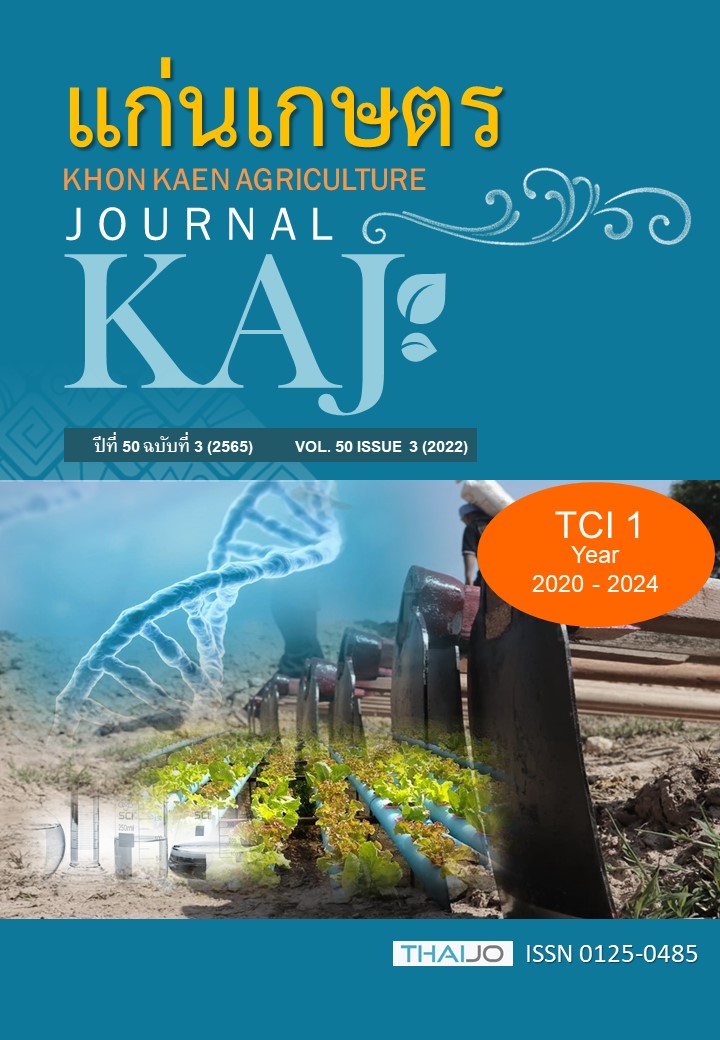การสร้าง infectious clones และทดสอบความสามารถในการก่อโรคของไวรัสใบหงิกเหลืองพริก
Main Article Content
บทคัดย่อ
งานวิจัยนี้มีวัตถุประสงค์ในการสร้าง Infectious clones ของเชื้อไวรัสสาเหตุโรคใบหงิกเหลืองพริกที่พบในประเทศไทย และศึกษาความสามารถในการก่อโรคของ Infectious clones ใช้เชื้อ Pepper yellow leaf curl Thailand virus (PepYLCTHV) ไอโซเลท BRM103 เป็นต้นแบบในการออกแบบไพรเมอร์เพื่อสร้าง infectious clones โดยการโคลน DNA-A และ DNA-B fragments เข้าสู่ pRI101 binary vector ถ่ายฝาก recombinant plasmid เข้าสู่ Agrobacterium tumefaciens สายพันธุ์ LBA4404 ผลจากการทดสอบความสามารถในการก่อโรคโดยใช้ยาสูบ (Nicotiana benthamiana) และพริก (Capsicum spp.) เป็นพืชทดสอบด้วยวิธี Agroinoculation พบว่า พืชทั้งสองชนิดสามารถแสดงอาการใบหงิกเหลืองซึ่งเป็นอาการที่เกิดจากเชื้อเบโกโมไวรัสได้ โดยมีเปอร์เซ็นต์การติดเชื้อ 100% และ 10% ตามลำดับ ซึ่งพบอาการของโรคเฉพาะในกรรมวิธีที่ปลูกเชื้อด้วย pRI101DNA-A ร่วมกับ pRI101DNA-B เท่านั้น ผลจากงานวิจัยจึงเป็นอีกทางเลือกหนึ่งของการถ่ายทอดเชื้อไวรัส PepYLCTHV นอกจากการใช้แมลงพาหะ ซึ่งเป็นประโยชน์ต่อการศึกษาวิจัยเกี่ยวกับเชื้อไวรัสชนิดนี้และสามารถนำไปประยุกต์กับการปรับปรุงพันธุ์พืชให้ต้านทานโรคใบหงิกเหลืองพริกได้ต่อไป
Article Details

อนุญาตภายใต้เงื่อนไข Creative Commons Attribution-NonCommercial-NoDerivatives 4.0 International License.
เอกสารอ้างอิง
เครือพันธุ์ กิตติปกรณ์ และวันเพ็ญ ศรีทองชัย. 2545. โรคไวรัสที่สำคัญของพืชผักและพืชน้ำมัน. โรงพิมพ์ชุมนุมสหกรณ์การเกษตรแห่งประเทศไทย จำกัด, กรุงเทพฯ.
ณัฐทนง บุพิ. 2563. การสร้างโคลนก่อโรคและความสามารถในการก่อโรคของไวรัสใบหงิกเหลืองพริก. วิทยานิพนธ์ปริญญาวิทยาศาสตรมหาบัณฑิต มหาวิทยาลัยเกษตรศาสตร์, กรุงเทพฯ.
ณัฐทนง บุพิ และรัชนี ฮงประยูร. 2563. ลำดับนิวคลีโอไทด์ที่สมบูรณ์ของเบโกโมไวรัสสาเหตุโรคใบหงิกเหลืองพริกในภาคตะวันออกเฉียงเหนือของประเทศไทย. แก่นเกษตร. 48(5): 954-965.
พิสสวรรณ เจียมสมบัติ และบุณณดา ศรีคำผึ้ง. 2558. ความแตกต่างทางพันธุกรรมของเบโกโมไวรัสสาเหตุโรคใบหงิกเหลืองของมะเขือ เทศและพริกและการถ่ายทอดโรคด้วยแมลงหวี่ขาว. น. 28-29. ใน: การประชุมวิชาการอารักขาพืชแห่งชาติ ครั้งที่ 12 อารักขาพืชเพื่ออาหารปลอดภัย เสริมสร้างเศรษฐกิจไทยให้ยั่งยืน 20-22 ตุลาคม 2558. โรงแรมดุสิต ไอส์แลนด์ รีสอร์ท, เชียงราย.
Arneodo, J., S.D. Breuil, S. Lenardon, and L. Conci. 2005. Brief note natural infection of Viola cornuta (Violaceae) with Cucumber mosaic virus, subgroup I. Biocell. 29(2): 205-207.
Bally, J., K. Nakasugi, F. Jia, H. Jung, S.Y. Ho, M. Wong, C.M. Paul, F. Naim, C.C. Wood, R.N. Crowhurst, and R.P. Hellens. 2015. The extremophile Nicotiana benthamiana has traded viral defence for early vigour. Nature Plants. 1(11): 15165.
Charoenvilaisiri, S., C. Seepiban, N. Phironrit, B. Phuangrat, K. Yoohat, R. Deeto, O. Chatchawankanphanich, and O. Gajanandana. 2020. Occurrence and distribution of begomoviruses infecting tomatoes, peppers and cucurbits in Thailand. Crop Protection. 127: 104948.
Fiallo-Olivé, E., L-L Pan, S.-S. Liu, and J. Navas-Castillo. 2020. Transmission of begomoviruses and other whitefly-borne viruses: dependence on the vector species. Phytopathology. 110: 10-17.
Gibson, D.G., L. Young, R. Y. Chuang, J.C. Venter, C.A. Hutchison, and H.O. Smith. 2009. Enzymatic assembly of DNA molecules up to several hundred kilobases. Nature methods. 6(5): 343-345.
Goodin, M.M., D. Zaitlin, R.A. Naidu, and S.A. Lommel. 2008. Nicotiana benthamiana: its history and future as a model for plant–pathogen interactions. Molecular plant-microbe interactions. 21(8): 1015-1026.
Hanley-Bowdoin, L., S. B. Settlage, B.M. Orozco, S. Nagar, and D. Robertson. 2000. Geminiviruses: models for plant DNA replication, transcription, and cell cycle regulation. Critical Reviews in Biochemistry and Molecular Biology. 35(2): 105-140.
Kalendar, R., B. Khasssenov, Y. Ramankulov, O. Samuilova, and K. I. Ivanov. 2017. FastPCR: An in silico tool for fast primer and probe design and advanced sequence analysis. Genomics. 109(3-4): 312-319.
Kenyon, L., S. Kumar, W.-S. Tsai, and J.A. Hughes. 2014. Chapter Six - Virus diseases of peppers (Capsicum spp.) and their control. Advances in Virus Research. 90: 297-354.
Koeda, S., K. Homma, Y. Tanaka, E. Kesumawati, S. Zakaria, and S. Kanzaki. 2017. Highly efficient agroinoculation method for tomato plants with Tomato yellow leaf curl Kanchanaburi virus. The Horticulture Journal. 86(4): 479-486.
Koeda, S., K. Homma, Y. Tanaka, D. Onizaki, E. Kesumawati, S. Zakaria, and S. Kanzaki. 2018. Inoculation of capsicums with Pepper yellow leaf curl Indonesia virus by combining agroinoculation and grafting. The Horticulture Journal. 87(3): 364-371.
Kumar, S., S. Kumar, M. Singh, A.K. Singh, and M. Rai. 2006. Identification of host plant resistant to pepper leaf curl virus in chilli (Capsicum species). Scientia horticulturae. 110: 359-361.
Marte, M., and C. Wetter. 1986. Occurrence of pepper mild mottle virus in pepper cultivars from Italy and Spain. Journal of Plant Diseases and Protection. 93(1): 37-43.
Phatsaman, T. 2017. Epidemiology of pepper viruses in Thailand and development of diagnostic techniques for related tobamoviruses. Ph.D. Thesis, Graduate School Kasetsart University, Thailand.
Sanger, F., and A. R. Coulson. 1975. A rapid method for determining sequences in DNA by primed synthesis with DNA polymerase. Journal of molecular biology. 94(3): 441-448.
Saxena, S., and A. K. Tiwari. 2017. Begomoviruses: Occurrence and management in Asia and Africa. Springer, Singapore.
Sulandari, S., S. H. Hidayat, R. Suseno, J. Harjosudarmo, and S. Sosromarsono. 2007. Transmission of pepper yellow leaf curl virus by the insect vector Bemisia tabaci Genn. (Hemiptera: Aleyrodidae). Journal of the International Society for Southeast Asian Agricultural Sciences. 13(1): 10-17.
Zhang, W., N. H. Olson, T. S. Baker, L. Faulkner, M. Agbandje-McKenna, M. I. Boulton, and R. McKenna. 2001. Structure of the Maize streak virus geminate particle. Virology. 279(2): 471-477.


